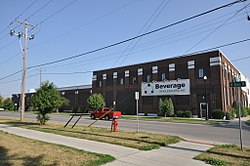
Granite Park Chalet is located in the heart of Glacier National Park in the U.S. state of Montana at an elevation of 6,693 feet above sea level. The chalet was built in 1914 by the Great Northern Railway and is a National Historic Landmark contributing property, being one of five structures in the Great Northern Railway Buildings district. From Logan Pass along the Going-to-the-Sun Road, the chalet is a moderate 7.6 miles (12.2 km) hike along the famed Crown of the Continent Highline Trail, usually referred to simply as the Highline Trail. Much of the trail passes through the scenic Garden Wall section of the park, immediately west and parallel to the Continental Divide. The chalet is also accessible via the Loop Trail and the Swiftcurrent Trail. The trails are for hikers and horseback riders only; no vehicle access is provided. Granite Park Chalet is a limited services facility and those that spend the night make use of the full service kitchen to cook their own meals.
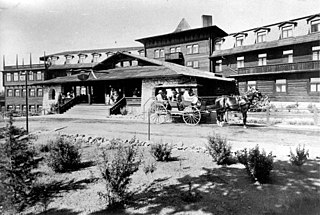
The El Tovar Hotel, also known simply as El Tovar, is a former Harvey House hotel situated directly on the south rim of the Grand Canyon in Arizona, United States.

Princeton station in Princeton, Minnesota, United States, is a former passenger and freight depot on the Great Northern Railway. The building is a combination of Queen Anne and Jacobean architectural styles, built of local brick with sandstone trim. It was listed on the National Register of Historic Places in 1977 as the Great Northern Depot.

The Great Atlantic and Pacific Tea Company Warehouse is a historic formerly commercial building at 150 Bay Street in Jersey City, Hudson County, New Jersey, United States. Built as a warehouse for The Great Atlantic & Pacific Tea Company (A&P) in 1900, it is the major surviving remnant of a five-building complex of the nation's first major grocery store chain. It was designated a National Historic Landmark in 1978, and now houses a mix of residences and storage facilities.
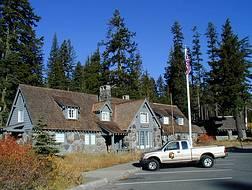
Munson Valley Historic District is the headquarters and main support area for Crater Lake National Park in southern Oregon. The National Park Service chose Munson Valley for the park headquarters because of its central location within the park. Because of the unique rustic architecture of the Munson Valley buildings and the surrounding park landscape, the area was listed as a historic district on the National Register of Historic Places (NRHP) in 1988. The district has eighteen contributing buildings, including the Crater Lake Superintendent's Residence which is a U.S. National Historic Landmark and separately listed on the NRHP. The district's NRHP listing was decreased in area in 1997.

The Willimantic Freight House and Office is a historic railroad freight facility on Bridge Street in the Willimantic section of Windham, Connecticut. Built in 1870, the freight office, a fine example of Second Empire architecture, is now the only surviving element of the city's 19th-century railroad buildings; the freight house has been demolished. The buildings were listed on the National Register of Historic Places in 1982 as an important reminder of the city's importance as a major railroad junction in eastern Connecticut.

The Crescent Warehouse Historic District is a 10.5-acre (4.2 ha) historic district in Downtown Davenport, Iowa, United States. The district is a collection of multi-story brick structures that formerly housed warehouses and factories. Most of the buildings have been converted into loft apartments. The district was listed on the National Register of Historic Places in 2003.

The Austin, Nichols and Company Warehouse, also known as 184 Kent Avenue and Austin Nichols House, is a historic warehouse building on the East River between North 3rd and North 4th Streets in Williamsburg, Brooklyn, New York City. The structure, measuring 179 by 440 feet, was built in the Egyptian Revival style; it is one of the city's few buildings in that style. The building was designed by architect Cass Gilbert and erected by general contractor Turner Construction with the help of structural engineer Gunvald Aus.

The National Building is a historic warehouse building in downtown Seattle, Washington, located on the east side of Western Avenue between Spring and Madison Streets in what was historically Seattle's commission district. It is now home to the Seattle Weekly. It is a six-story plus basement brick building that covers the entire half-block. The dark red brick facade is simply decorated with piers capped with small Ionic capitals and a small cornice, which is a reproduction of the original cornice. Kingsley & Anderson of Seattle were the architects.

The Dallas County Courthouse in Adel, Iowa, United States was built in 1902. It was individually listed on the National Register of Historic Places in 1973, and is a part of the County Courthouses in Iowa Thematic Resource. In 2009 it was included as a contributing property in the Adel Public Square Historic District. The current structure is the fourth building to house court functions and county administration.
Grand Forks freight station is a former freight warehouse in Grand Forks, North Dakota, United States, built for the Great Northern Railway in 1904, during the Second Dakota Boom.

Grand Forks station is a property in Grand Forks, North Dakota, United States, that was listed on the National Register of Historic Places in 1982 as the Northern Pacific Depot and Freight House. It was used both as a passenger station and a freight warehouse/depot by the Northern Pacific Railway.
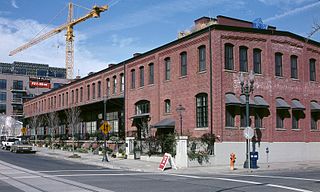
The North Bank Depot Buildings, in central Portland, Oregon, United States, are a pair of buildings formerly used as a freight warehouse and passenger terminal for the Spokane, Portland and Seattle Railway (SP&S). Formed in 1905, the SP&S was commonly known as the North Bank Road during the period in which these buildings were in use. The Portland buildings' passenger facilities were also used by the Oregon Electric Railway after that railway was acquired by the SP&S. Located in what is now known as the Pearl District, the buildings were listed on the National Register of Historic Places in 1996. They were in use by the SP&S and its successor, Burlington Northern Railroad, from 1908 until the 1980s. Only the east building was used as a passenger station, and this usage lasted from 1908 until 1931.

The Bloomington freight station is a historic train station in downtown Bloomington, Indiana, United States. Constructed in the early twentieth century, it has endured closure and a series of modifications to survive to the present day, and it has been declared a historic site. Used only occasionally for many years, it is one of the most important buildings in a large historic district on the city's west side.
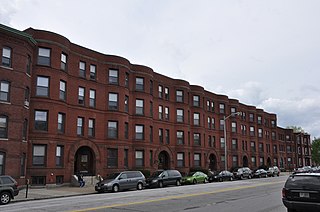
The Smith and Dow Block is a historic apartment house at 1426-70 Elm Street in Manchester, New Hampshire. When built in 1892, this four-story brick building was the largest apartment block in the state, and it still dominates its section of Elm Street. It has modest Romanesque styling elements, and was designed by William M. Butterfield, one of Manchester's leading architects, as an investment property for John Butler Smith and Frederick C. Dow. The building was listed on the National Register of Historic Places in 2002.

Winston-Salem Southbound Railway Freight Warehouse and Office is a historic railway freight warehouse and office building located at Winston-Salem, Forsyth County, North Carolina. It was built in 1913, and is a two-story, brick railroad building with a shallow gable roof and Italianate-style design elements. It measures 40 feet by 224 feet. The building served until 1985 as headquarters for the Winston-Salem Southbound Railway. In 1990, the building was sympathetically renovated for office use.

The Bellows Falls Times Building is a historic newspaper plant on Bridge and Island Streets in Bellows Falls, Vermont. The complex of three buildings was developed in the 1930s by the Vermont Newspaper Corporation, and served as home for the Bellows Falls Times newspaper until 1965, when it was consolidated with other local newspapers. The main building is a particularly fine local example of Colonial Revival design. The complex was listed on the National Register of Historic Places in 1990.
P. C. C. & St. L. Railroad Freight Depot, also known as the Central Union Warehouse, was a historic freight depot located at Indianapolis, Marion County, Indiana. It was built in 1916 by the Pittsburgh, Cincinnati, Chicago and St. Louis Railroad. It was a one-story, brick warehouse building measuring 790 feet long and 70 feet wide. It has been demolished.

The AT&SF Freight Office is a historic building in Downtown Albuquerque, New Mexico. It was built by the Atchison, Topeka and Santa Fe Railway in 1946 and is a notable example of Mission Revival architecture. The building was listed on the New Mexico State Register of Cultural Properties in 2012 and the National Register of Historic Places in 2013.

The McCord-Brady Company, at 1506 Thomes Ave. in Cheyenne, Wyoming, was built in 1914–15. It was listed on the National Register of Historic Places in 2003. It has also been known as Asher-Wyoming Company Wholesale Grocers and as Cheyenne Winlectric Company.
